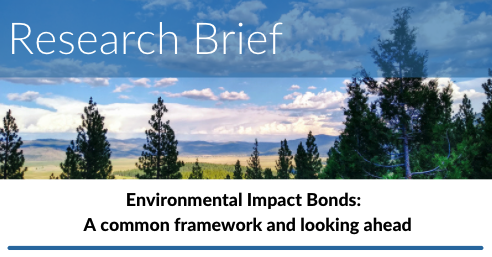The FRB: First Environmental Impact Bond of its Kind


As EIBs gain momentum with projects in the pipeline, including multiple FRBs, now is the time to develop a common framework and assess lessons learned and trends from projects that have been implemented or are planned.
Written by: Kim Quesnel Seipp, PhD
The Forest Resilience Bond is the first ever Environmental Impact Bond (EIB) aimed at wildfire risk reduction. While the success of the Yuba I FRB provides proof-of-concept, EIBs are still an emerging funding mechanism. These innovative financial instruments are not well understood or recognized beyond the conservation finance field. As EIBs gain momentum with projects in the pipeline, including multiple FRBs, now is the time to develop a common framework and assess lessons learned and trends from projects that have been implemented or are planned. Critically, more research is needed to refine and expand the product to enable EIBs to be deployed at their full potential.
Recognizing these needs, Blue Forest team members recently co-authored a research paper, led by Blue Forest science advisor Matthew Brand, Environmental Impact Bonds: A Common Framework and Looking Ahead to define EIB mechanics while laying out a research agenda for this emerging conservation finance tool.
“EIBs can leverage research that has already been done for flood mitigation, wildfire prevention, and water quality,” said Matthew Brand, who wrote the article as an outcome of his University of California-Irvine dissertation. He now is a postdoctoral researcher at Pacific Northwest National Laboratory.
“This is intended as a road map for the EIB process, with questions to answer and common vocabulary to help non-profits, universities, and small utilities strengthen their EIB applications,” Brand said. “The goal is to help EIBs be better thought out and easier to finance, so the groups can get their funding for restoration and prevention projects.” For example, the paper outlines various repayment structures that an EIB could take on.
“We really wanted to set the stage for EIB development as conservation finance becomes increasingly important for moving the needle on environmental projects. With only a few EIBs currently closed, there is even a discrepancy with definitions. We want to change that.” said Blue Forest Senior Project Scientist Kim Quesnel Seipp. “We also developed a Research Brief based on the paper because we really want the information gathering and synthesis to be useful not only for academics but for practitioners as well.”